
How to Become a Broker in 2026?
Contents
To begin trading as a broker, you will need to register a legal person, obtain licenses, determine a market niche, establish your trading infrastructure, and obtain clients through marketing. It’s a structured process involving planning, compliance, technology deployment, and continuous innovation.
Here’s a step-by-step guide that covers everything from selecting a niche and legal compliance to building your platform, opening for business, and expanding your brokerage successfully.
Broker Requirements Checklist (Quick-Start)
- Choose your niche & audience (Forex, stocks, crypto, commodities; trader profiles)
- Choose jurisdiction (timeline, capital, tax, and regulator fit)
- Form company (legal entity, corporate documents, directors, shareholding)
- License & compliance plan (license application, appoint Compliance Officer, prepare AML/KYC, risk & reporting policies)
- Capital & finance (minimum capital requirement, bank account opening, payments/PSPs setup)
- Technology stack (trading platform, liquidity bridge, data feeds, hosting)
- Back-office & CRM (KYC/ONB, client portal, ticketing, billing, analytics)
- Security & data protection (cybersecurity controls, backups, GDPR/PDPA)
- Liquidity & execution (LP agreements, routing, slippage & risk parameters)
- Business plan & model (P&L, runway, pricing/spreads, IB/affiliate terms)
- Website & legal docs (T&Cs, Risk Disclosure, Privacy, Cookie, PEP/Sanctions screening)
- Go-to-market (SEO/content, paid acquisition, partnerships, IB network)
- Client education & support (knowledge base, webinars, multilingual support SLAs)
- Pre-launch testing (UAT, sandbox trades, load & security tests, incident playbooks)
- Ongoing obligations (regulatory reporting, audits, reconciliation, roadmap iteration)
Steps to Become a Broker
- Define Your Broker Niche
- Legal Registration and Compliance
- Develop a Business Plan
- Set Up Operational Infrastructure
- Implement Marketing and Client Acquisition Strategies
- Embracing Innovation and Technological Advancements
Now that we have outlined the essential steps to become a broker, let’s delve deeper into each one to understand the detailed processes and best practices involved in successfully launching and managing a brokerage firm.
Step 1: Define Your Broker Niche
One of the most critical decisions in the initial stages of setting up a broker is selecting the right niche. This choice will significantly influence your business model, the clientele you attract, and how you navigate the regulatory environment. The niche you select – be it stocks, Forex, real estate, commodities, or others – sets the tone for your entire operation.
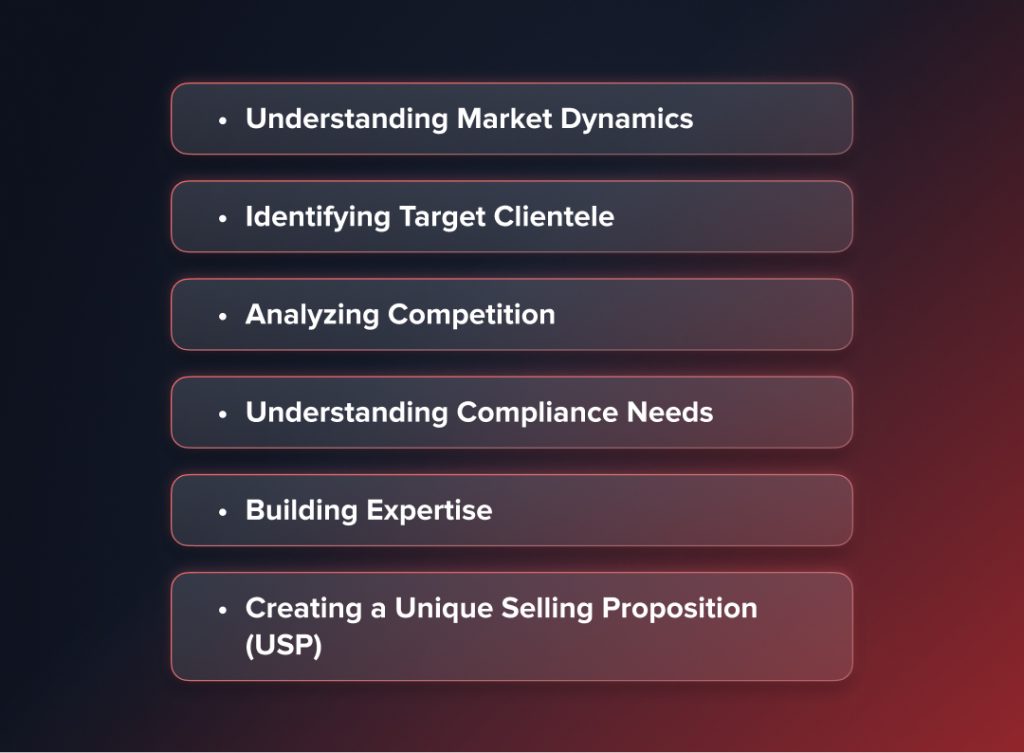
Understanding Market Dynamics
Before deciding on a niche, research the potential markets’ current dynamics, trends, and future projections. This involves analyzing market size, growth potential, and volatility, which are crucial in determining the sustainability and profitability of the niche.
Identifying Target Clientele
Each niche attracts a different type of client. For instance, Forex markets may appeal to clients interested in a fast-paced trading environment, while real estate might attract those looking for long-term investments. Understanding your target clientele’s needs, behaviors, and preferences is essential in effectively tailoring your services.
Analyzing Competition
Research the existing competition in your chosen niche. Identify the major players, their offerings, strengths, and weaknesses. This insight will help you differentiate your services and find gaps in the market that your brokerage can fill.
Understanding Compliance Needs
Different niches come with varying regulatory requirements. For instance, stock brokerages need to comply with different regulations than Forex or real estate brokerages. Familiarize yourself with these requirements early on to ensure compliance and avoid legal pitfalls.
You may also like

Building Expertise
Depending on the niche, you may need specific expertise or certifications. For example, a real estate brokerage would benefit from expertise in property law and local real estate markets, while a stock brokerage might require in-depth knowledge of equity markets and trading technologies.
Creating a Unique Selling Proposition (USP)
Once you understand your niche, think about what unique value your brokerage can offer. This could be innovative technology, superior customer service, niche market expertise, or competitive pricing. Your USP is what will set you apart from the competition and attract clients to your brokerage.
Bottom Line
Defining your broker niche is not just about selecting a market segment; it’s about aligning your business vision with market opportunities and client needs. A well-chosen niche, backed by thorough research and a clear understanding of regulatory requirements, lays a strong foundation for your brokerage firm.
Brokerage Business Models: Which One Is Right for You?
Before you develop a platform or apply for a license, you need to figure out how your brokerage will operate. Your business model affects everything, from regulation and tech stack to revenue and user experience.
Common Brokerage Models Explained
1. Dealing Desk (Market Maker)
- You act as the counterparty to client trades, providing bid and ask prices internally.
- Pros: More revenue potential via spreads and order flow.
- Cons: Requires tight liquidity management and is riskier.
- Best for: Well-capitalized brokerages that target retail customers with tight spreads.
2. STP (Straight Through Processing)
- Orders are sent directly to external liquidity providers without dealing desk intervention.
- Pros: Less risk and less conflict of interest.
- Cons: Profit margins are narrower as revenue is based mainly on spreads or commissions.
- Best for: Start-up or medium-sized brokers that prioritize transparency and low-risk operations.
3. ECN (Electronic Communication Network)
- Client orders are matched with other market participants within an environment of pooled liquidity.
- Pros: Extremely transparent pricing, tighter spreads, and no dealing desk risk.
- Cons: Sophisticated technology requirements, higher setup costs, and more regulatory oversight.
- Best for: Institutional-grade brokers or brokers focusing on professional traders.
4. White Label Brokerage
- You make an agreement with a technology provider who supplies the trading platform as well as infrastructure.
- Pros: Rapid time-to-market, significantly lower startup costs, and seamless scalability.
- Cons: Less control over technology and potential limits on customization.
- Best for: New brokerage founders or those testing new markets.
Choosing the right model from the start enables you to align your licensing strategy, tech stack, liquidity setup, and marketing strategy from day one.
Step 2: Legal Registration and Compliance
The next step involves legally registering the business and ensuring compliance with all relevant laws and regulations. This process varies based on location and the type of brokerage. To establish a credible and lawful operation, it’s essential to understand the legal framework governing financial brokerages in the desired region and adhere strictly to these regulations.
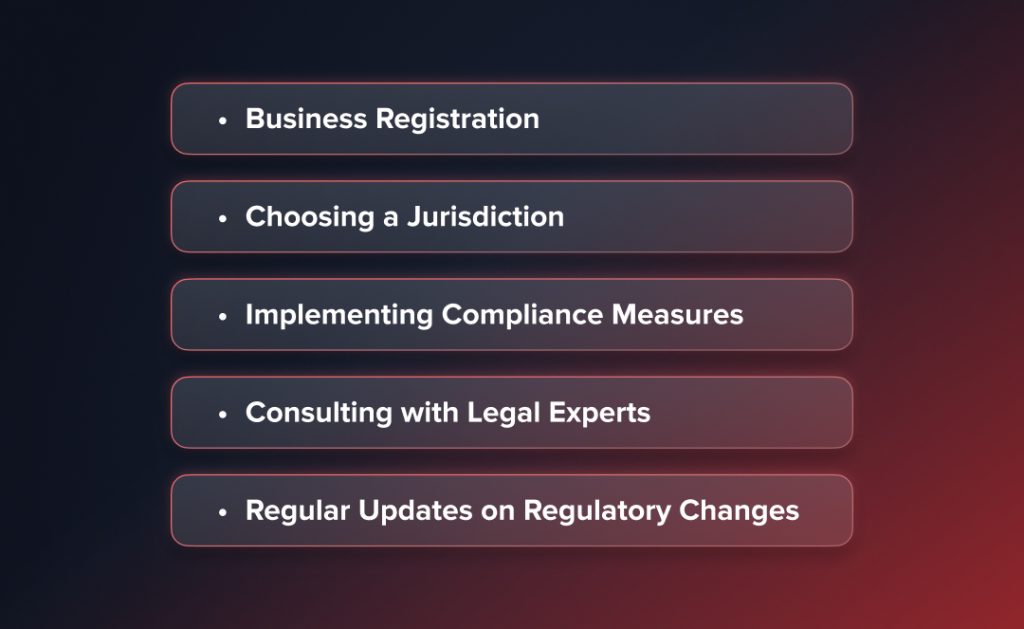
Business Registration
The first step is to register your brokerage as a business entity legally. This involves selecting an appropriate business structure (such as a corporation, partnership, or sole proprietorship) that can affect taxation, liability, and regulatory compliance. The registration process typically requires submitting specific documents and information about your brokerage to the relevant governmental authority.
Choosing a Jurisdiction
The legal requirements for brokerages can vary significantly from one region to another. Choosing a jurisdiction that aligns with your business goals and regulatory comfort level is important. Consider factors like the regulatory environment, tax implications, and the political and economic stability of the region.
Implementing Compliance Measures
Ensuring ongoing compliance involves setting up internal policies and procedures that align with regulatory standards. This includes measures for client protection, financial reporting, anti-money laundering (AML) practices, and other compliance-related processes.
Consulting with Legal Experts
Given the complexities of financial regulations, consulting with legal experts specializing in financial services is highly advisable. They can provide guidance on the registration process, necessary licenses, and ongoing compliance requirements.
Regular Updates on Regulatory Changes
The financial regulatory environment is dynamic, with frequent updates and changes. Staying informed about these changes and adapting your compliance strategies accordingly is essential to maintain legal standing and protect your business from potential legal issues.
Bottom Line
Legal registration and compliance are not just bureaucratic steps but fundamental to establishing and operating a credible and trustworthy brokerage firm.
Broker License Requirements by Region
One of the most important early decisions is where to register and license your brokerage. Each jurisdiction has different capital requirements, regulatory expectations, and approval timelines, each impacting your costs, speed to market, and long-term strategy.
| Jurisdiction | Main Regulator | Minimum Capital | License Type | Typical Timeline |
| USA | FINRA / SEC | $50,000+ | Broker-Dealer License | 4-6 months |
| UK | FCA | £100,000+ | FCA Investment Firm License | 3-5 months |
| Cyprus (EU) | CySEC | €125,000+ | CIF License | 3-6 months |
| UAE | DFSA / FSRA | $250,000+ | Financial Services License | 4-8 months |
| Australia | ASIC | AUD 50,000+ | Australian Financial Services License (AFSL) | 4-6 months |
| Mauritius | FSC | $25,000+ | Investment Dealer License | 2-4 months |
| Seychelles | FSA | $50,000+ | Securities Dealer License | 2-3 months |
Your jurisdiction choice determines your entire brokerage strategy. Consider client location, marketing strategy, regulatory burden, tax environment, and investor confidence before submitting an application.
Step 3: Develop a Business Plan
Developing a business plan is crucial in laying the foundation for a successful brokerage. This plan is not merely a financial blueprint; it’s a comprehensive strategy encompassing every aspect of your business, guiding its growth and ensuring operational stability.
Key Components of a Brokerage Business Plan
- Executive Summary: Begin with a clear and concise executive summary that outlines your broker’s mission, vision, and primary objectives. This section should provide a snapshot of your business strategy and what you aim to achieve in the brokerage industry.
- Market Analysis: Conduct a thorough market analysis, including assessing potential clients, competitors, and overall market trends. This analysis should give insights into where your brokerage fits in the market and how it can capitalize on unmet needs or emerging trends.
- Services and Products: Detail your brokerage’s range of services and products. This should align with your chosen niche and target market, whether it’s stock trading, Forex trading, commodities trading, or other financial instruments.
- Operational Plan: Outline how your brokerage will operate on a day-to-day basis. This includes your business location, the technology and platforms you will use, staffing needs, and any other operational logistics.
- Marketing and Sales Strategy: Develop a comprehensive marketing and sales strategy. Describe how you will attract and retain clients, including your branding approach, marketing channels, and sales tactics.
- Financial Projections: Financial projection is a critical component of your business plan. This should include startup costs, projected revenue, profit and loss forecasts, cash flow analysis, and a break-even analysis. Be realistic in your projections and base them on thorough market research and sound financial principles.
- Risk Management: Address potential risks and challenges your brokerage might face and how you plan to mitigate them. This could include market risks, regulatory changes, or operational challenges.
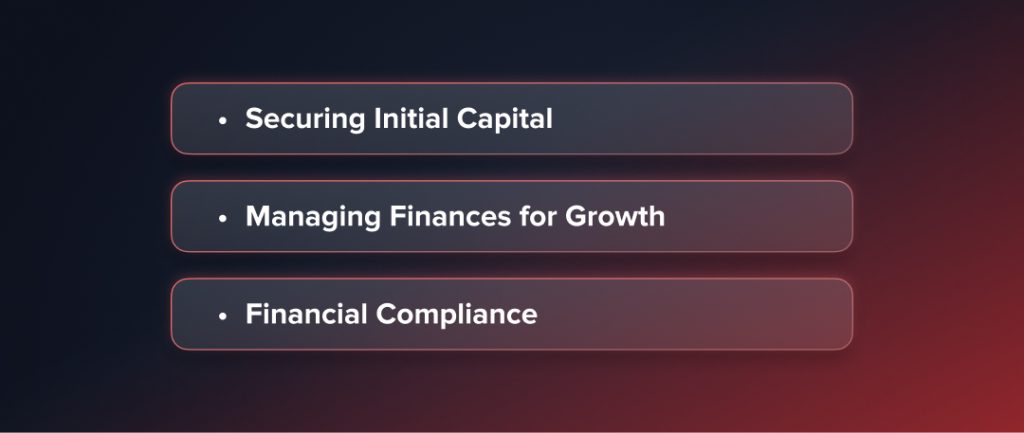
Securing Initial Capital
Determine the amount of capital required to start your broker and maintain operations until it becomes profitable. Explore various funding sources, including personal savings, loans, investor funding, or partnerships.
You may also like

Managing Finances for Growth
It’s essential to have a strategy for managing your brokerage’s finances effectively. This includes prudent financial management, budgeting, and reinvestment of profits to support sustainable growth and operational stability.
Financial Compliance
Ensure that your financial management practices comply with regulatory requirements, especially concerning client funds, capital reserves, and financial reporting.
Bottom Line
A well-crafted business plan is your brokerage’s roadmap to success. It guides your decisions, helps secure funding, and prepares you for future challenges and opportunities. This plan should be dynamic, evolving as your brokerage grows and the market changes, ensuring that your firm remains on course for long-term success and stability in the financial services sector.
How Much Does It Cost to Set Up a Brokerage?
One of the first questions potential brokers ask is: “How much money do I need to start up?” The answer depends on your business model, jurisdiction, and level of technology, but here’s a rough notion of typical startup costs:
| Expense Category | Estimated Range |
| Company registration & legal setup | $5,000 – $20,000 |
| Regulatory licensing & minimum capital | $50,000 – $250,000+ |
| Trading platform & technology infrastructure | $20,000 – $100,000+ |
| Website, client portal & CRM systems | $5,000 – $30,000 |
| Marketing & client acquisition | $10,000 – $50,000 |
| Staff salaries & operational costs (first year) | $50,000 – $200,000+ |
If building from scratch is too expensive, consider white label brokerage solutions. These ready-made platforms enable you to launch much more quickly and typically cost as little as $20,000, which significantly lowers your up-front investment.
Timeline: How Long Does It Take to Start a Brokerage?
Establishing a brokerage doesn’t occur overnight: it typically requires 6 to 12 months from conceptualization to the eventual launch in the market. The duration may vary depending on your jurisdiction of choice, licensing complexities, as well as technology setup.
Average Timeline to Establish a Brokerage Firm:
- Month 1-2: Conduct market research, choose your niche, and determine your business model.
- Month 2-4: Register the company, prepare compliance documents, and submit your license application.
- Month 4-6: Choose and implement trading platforms, build infrastructure, hire core team members, and set up internal processes.
- Month 6-8: Build and test your marketing campaigns, build your website, and have a soft launch or beta phase.
- Month 8-12: Officially launch your brokerage, acquire customers, and scale acquisition efforts.
Important: In highly regulated markets like the USA, UAE, or UK, the licensing itself can push timelines to over 12 months, so plan your launch strategy accordingly.
Step 4: Set Up Operational Infrastructure
Setting up the operational infrastructure is a pivotal step in launching your brokerage. This phase involves creating your business’s physical and technological backbone, ensuring it supports efficient operations and provides top-notch service to clients.
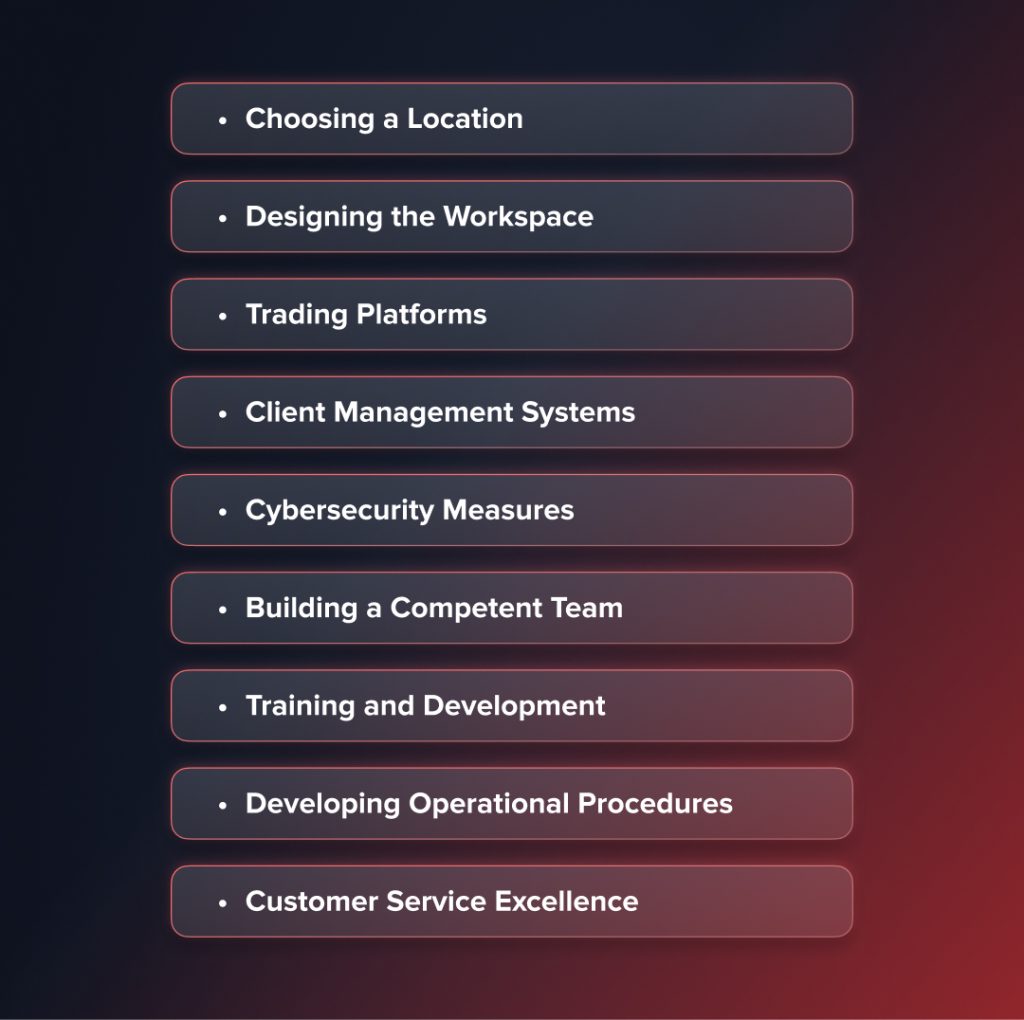
Choosing a Location
Decide whether to establish a physical office, operate virtually, or combine both. For a physical office, consider factors like accessibility for clients and staff, proximity to financial districts, and overall costs. Meanwhile, virtual operations offer flexibility and reduced overhead but require robust technology solutions.
Designing the Workspace
If opting for a physical office, design a workspace that fosters productivity and reflects your brokerage’s brand. It should have the necessary technology and resources to support your team’s operations.
Trading Platforms
Selecting the right trading platforms is crucial. These platforms should be reliable, user-friendly, and equipped with advanced trading tools and analytics. When choosing platforms, consider the needs of your target clientele.
Client Management Systems
Implement client management systems to handle client accounts, transactions, and communications efficiently. These systems should ensure secure and seamless operations, from account opening to trade execution.
Cybersecurity Measures
In today’s digital world, robust cybersecurity measures are non-negotiable. Invest in top-tier security infrastructure to protect sensitive data and client funds from cyber threats.
Building a Competent Team
Assemble a team of skilled professionals who align with your brokerage’s values and goals. This includes hiring experienced brokers, financial analysts, IT specialists, and support staff.
Training and Development
Investing in regular training and development is essential to keep your team updated with the latest market trends, regulatory changes, and technological advancements.
Developing Operational Procedures
Establish clear operational procedures for all aspects of your brokerage, from client onboarding to compliance checks. This ensures consistency and efficiency in daily operations.
Customer Service Excellence
Set up a dedicated customer service team or system to promptly address client inquiries and issues. Excellent customer service is crucial for client retention and reputation building.
Bottom Line
The operational infrastructure of your brokerage is the engine that drives its success. By carefully setting up your office, investing in the right technology, building a skilled team, and streamlining operations, you lay the groundwork for a brokerage that operates smoothly, meets client needs effectively, and stands out in the competitive financial market.
Technology Stack Essentials for a Brokerage
Your brokerage’s technology infrastructure is its backbone. It directly affects trading execution speed, client experience, compliance, and scalability. Having the right tools in place from the beginning makes everything run more smoothly and enables you to stay competitive as you grow.
Key Technology Every Brokerage Needs
Trading Platform
The heart of your business, where all trading activity is executed. Broker favorites include MetaTrader 5 (MT5), cTrader, or a bespoke in-house platform. Look for features like fast execution, multi-asset class coverage, mobile access, and customizable interfaces.
Risk Management Tools
Essential for managing exposure and protecting capital. Liquidity bridges, real-time exposure dashboards, and automated risk alerts allow you to manage order flow and maintain financial stability.
CRM & Client Portal
A robust CRM system streamlines onboarding, KYC/AML verification, and client communication. Integrated client portals increase transparency, allowing users to monitor trades, deposits, and performance in real time.
Payment Processing Solutions
Enable multi-currency payments, instant deposits, and seamless withdrawals. Integration with major payment gateways (e.g., Stripe, Worldpay) and PSPs is crucial to reduce friction and improve user experience.
Compliance & AML Systems
Automated compliance software handles KYC checks, transaction monitoring, suspicious activity reports, and regulatory reporting. This not only guarantees legal compliance but also builds trust with regulators and clients.
Hosting & Infrastructure
High-performance servers, VPS solutions, and backup systems guarantee platform uptime and low latency, both of which are critical for execution speed and client satisfaction.
Prioritize scalability and integrations. Your technology stack must be capable of supporting new asset classes, international client bases, and evolving regulatory requirements as your brokerage grows.
Step 5: Implement Marketing and Client Acquisition Strategies
Developing and implementing effective marketing and client acquisition strategies for any new brokerage are vital steps toward ensuring growth and establishing a robust presence in the competitive financial market.
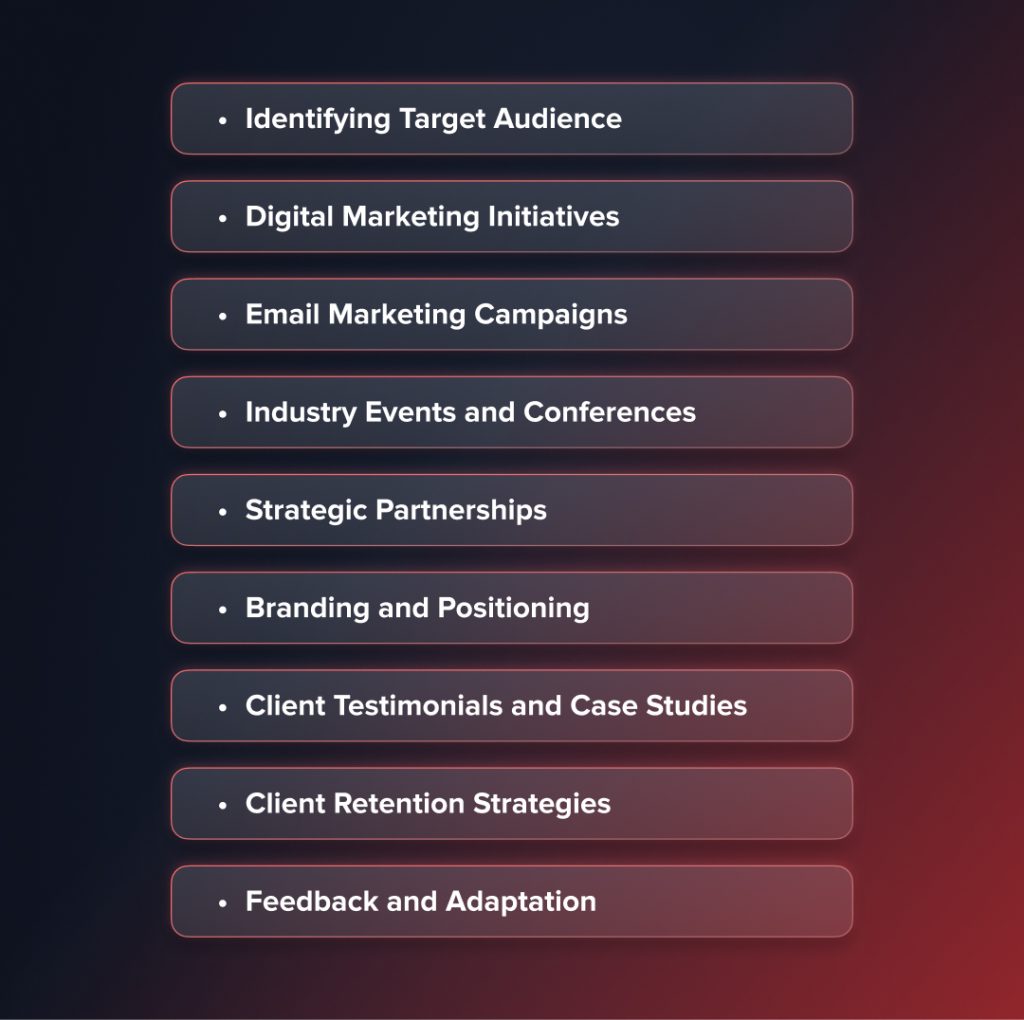
Identifying Target Audience
Begin by identifying your target audience based on your brokerage niche. Understanding your potential clients’ demographics, trading behaviors, and preferences is key to tailoring your marketing efforts effectively.
Digital Marketing Initiatives
In today’s digital-centric world, having a strong online presence is essential. This can include search engine optimization (SEO) to improve your visibility on search engines, content marketing to establish your expertise and provide value to potential clients, and social media marketing to engage with clients on platforms they frequent.
Email Marketing Campaigns
Utilize email marketing to keep potential and existing clients informed and engaged. Regular newsletters, market updates, and personalized offers can effectively maintain ongoing communication and build relationships.
Industry Events and Conferences
Participate in industry events, conferences, and webinars to network with potential clients and partners. These events offer brand visibility and can showcase your brokerage’s expertise and services.
Strategic Partnerships
Forming partnerships with financial educators, trading experts, or complementary service providers can open avenues for client referrals and shared marketing efforts. These partnerships can extend your reach to new client segments.
Branding and Positioning
Develop a strong brand identity and ensure your branding is consistent across all marketing materials and channels. Position your brokerage uniquely in the market to differentiate yourself from competitors.
Client Testimonials and Case Studies
Leverage client testimonials and case studies to build credibility and trust. Sharing success stories of satisfied clients can be a powerful tool in attracting new clients.
Client Retention Strategies
Beyond acquiring new clients, focus on retention strategies to build a loyal customer base. This includes providing exceptional customer service, offering personalized trading advice, and consistently delivering value.
Feedback and Adaptation
Regularly seek feedback from clients and adapt your strategies accordingly. Staying attuned to client needs and market changes ensures your marketing efforts remain relevant and effective.
Bottom Line
Implementing effective marketing and client acquisition strategies is a dynamic and ongoing process that requires adaptability, creativity, and a deep understanding of your target market. By combining digital marketing, networking, strategic partnerships, and strong branding, your brokerage can build a significant presence in the market, attract a diverse client base, and foster long-term client relationships essential for sustained growth.
Step 6: Embracing Innovation and Technological Advancements
In the fast-paced brokerage world, staying ahead often means embracing the latest technological advancements and innovative practices. This step is crucial for enhancing operational efficiency, improving client experience, and maintaining a competitive edge in the market.
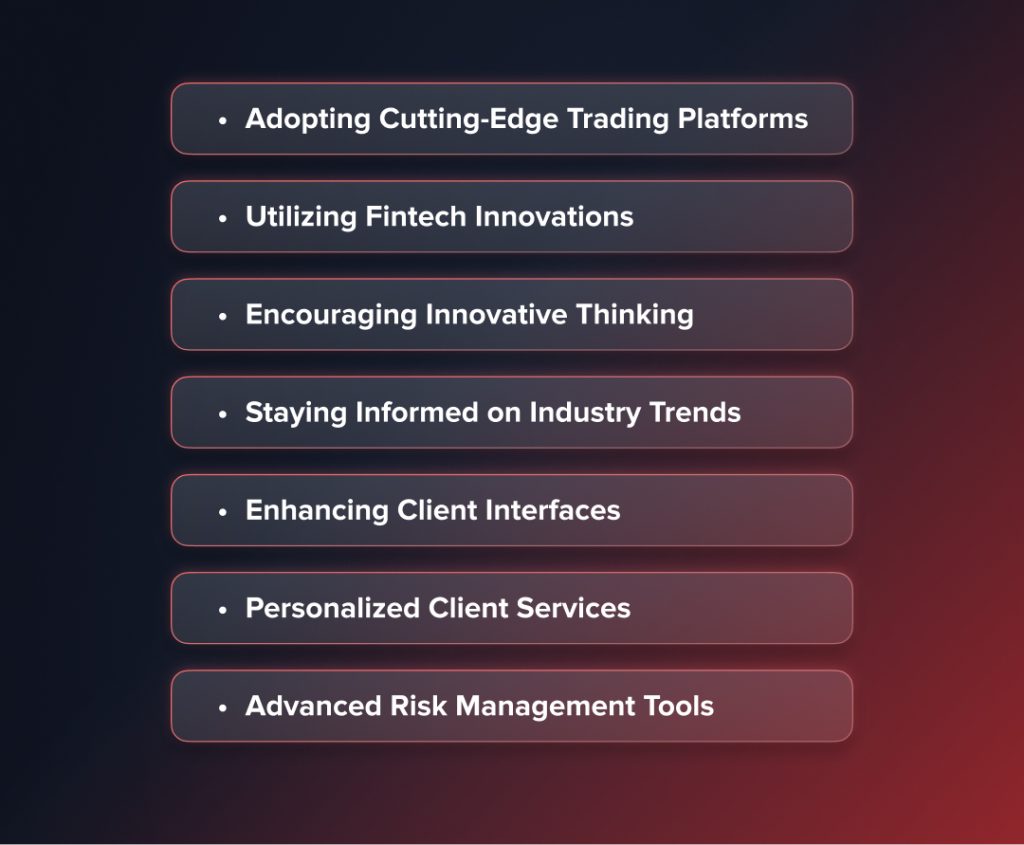
Adopting Cutting-Edge Trading Platforms
Continuously evaluate and integrate advanced trading platforms that offer superior performance, enhanced security, and better user experience. This could include platforms with AI-driven analytics, automated trading capabilities, and real-time data processing.
Utilizing Fintech Innovations
Explore fintech innovations such as blockchain for secure transactions, robo-advisors for automated client advice, and big data analytics for market insights. These technologies can significantly improve service offerings and operational efficiency.
Encouraging Innovative Thinking
Cultivate a work environment that encourages creativity and innovative thinking. Regular brainstorming sessions, innovation workshops, and incentives for innovative ideas can stimulate a culture of continuous improvement and adaptation.
Staying Informed on Industry Trends
Keep abreast of the latest trends and developments in the financial and technology sectors. Attend industry conferences, subscribe to relevant publications, and participate in professional networks to gather new ideas and insights.
Enhancing Client Interfaces
Regularly update client-facing technologies such as mobile apps, client portals, and communication tools to ensure they are user-friendly and feature-rich and provide a seamless client experience.
Personalized Client Services
Implement technology solutions that allow for personalized services to clients, such as custom investment portfolios, tailored risk assessment tools, and interactive financial planning interfaces.
Advanced Risk Management Tools
Utilize sophisticated risk management software to monitor and mitigate risks associated with trading activities. This includes tools for compliance monitoring, market risk analysis, and credit risk assessment.
Streamlining Broker Setup with White Label Solutions
For entrepreneurs looking to enter the Forex market, navigating the complexities of becoming a broker can be daunting. Each step involves significant effort and investment, from defining your niche and ensuring compliance to developing a business plan and operational infrastructure. However, a streamlined approach simplifies this process: leveraging white label solutions.
The Power of White Label Solutions
White label solutions offer a comprehensive package that covers the essential components needed to launch and operate a Forex brokerage. This approach provides a ready-to-market platform along with the necessary operational tools and services, all customizable under your brand. Here’s how white label solutions make becoming a Forex broker much easier:
- Rapid Market Entry: White label platforms are pre-developed, fully integrated, and ready to deploy. This significantly reduces the time to launch, allowing new brokerages to enter the market swiftly and efficiently, often within a few weeks.
- Cost-Effective: Developing a trading platform and infrastructure from scratch demands significant financial resources, often exceeding $100,000 due to the complexities of software development, regulatory compliance, and infrastructure setup. In contrast, white label solutions present a cost-effective alternative, with costs starting around $20,000, eliminating the need for heavy upfront investment in technology development.
- Customization and Branding: White label solutions offer extensive customization options despite being pre-built. Brokers can apply their branding and tailor the platform’s appearance and functionality to meet their and their clients’ specific needs.
- Regulatory Compliance: Many white label providers design their platforms with regulatory compliance in mind, easing the burden of meeting stringent financial regulations.
- Technical Support and Maintenance: Providers of white label solutions typically offer ongoing technical support and maintenance, ensuring that the platform operates smoothly and stays updated with the latest features and security measures.
Selecting a reputable white label provider is crucial. Look for providers with a proven track record, robust security measures, and comprehensive support. Consider the scalability of the solution, ensuring it can grow with your business. Also, evaluate the customization options and how well they can align with your vision for your brokerage.
Conclusion
Establishing a brokerage firm is a multifaceted process that demands diligence, expertise, and a strategic approach. By following these steps and remaining committed to ethical practices and continual improvement, aspiring brokerages can position themselves for success in the dynamic world of finance. Additionally, leveraging white label solutions can offer a streamlined path to market entry, providing a solid foundation while allowing focus on growth and client acquisition. This journey, while challenging, opens up opportunities for significant growth and impact in the financial markets, with white label solutions serving as a powerful accelerant on the path to success.
FAQ
It can take anywhere from 6 to 12 months to start a brokerage, depending on your jurisdiction, regulatory approval timeframe, and technology setup. In jurisdictions with more intense licensing (like the US or UAE), it can take over a year.
Yes. It is illegal to operate a Forex or securities brokerage business without a license in most jurisdictions. The licensing terms differ from region to region, but they generally have minimum capital, compliance policies, AML/KYC procedures, and ongoing reporting requirements.
Absolutely. The majority of brokerages commence without internal technical expertise by leveraging white label platforms or partnering with technology providers. These solutions handle setup, trading platforms, and back-office software so that you can focus on compliance, branding, and client acquisition.
Updated:
October 10, 2025
19 December, 2025
Top 10 White Label Casino Providers 2026
A white label casino is a ready-made online gambling platform that lets entrepreneurs start their own brand without building technology or securing licenses from scratch. In 2026, this model remains the fastest and most affordable way to enter the iGaming market. The leading white label casino providers in 2026 are SoftSwiss, BetConstruct, NuxGame, SoftGamings, FintechFuel, […]



